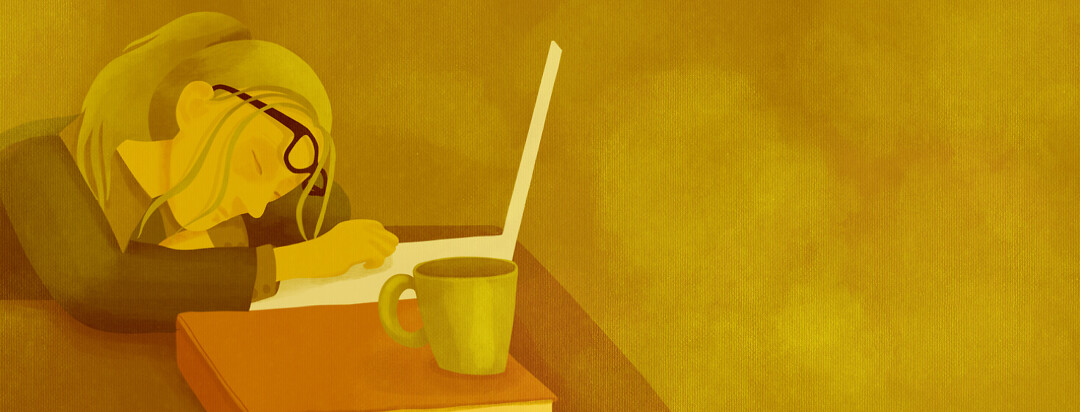Idiopathic Hypersomnia, Drowsy Driving, and the Diagnosis Hop
I must trace back decades to recall when I first realized daytime sleepiness wasn’t normal. Only after several hops from one diagnosis to the next did I understand the roots of my excessive daytime sleepiness (EDS).
EDS became a “thing” for me in high school. I blame contracting mononucleosis at age 15. I lost 6 weeks of school, sleeping like a hibernating bear, my parents rolling their eyes at my apparent laziness. And then, at age 19, I got a second case.
My struggle to stay awake
My first job out of college was at a publishing house in Chicago. Staring at manuscripts, computer screens, and galleys all day required lots of coffee, though I didn’t drink any more than anyone else.
I do remember situating my cubicle with my back to the door. I frequently propped my head up, chin in hand, at my desk to keep from collapsing in a nap, and didn’t want to get caught.
Commuter-hour naps
I began to worry, though, when I struggled to stay awake while driving home from work.
Taking the traffic-jammed Kennedy Expressway home from Skokie took about 75 minutes. I remember lots of brake lights and The Loop turned up loud on my car stereo. I’ve pulled over more times than I can count at the edge of the Chicago highway system, its own kind of death trap, to nap at 5:30 at night.
Life as a working mom
Over time, life changed; I became a freelance writer and started a family. Both occupations lend themselves to daytime sleepiness. Do both and there just isn’t enough coffee in the world. But I was a working mom; who was I to complain about being tired?
I couldn’t blame my daytime sleepiness on parental sleep deprivation. Both girls, as babies, slept well. Instead, when they napped, I napped along with them.
Asleep on the job
Fast forward 10 years. I began waking up with a raw throat and struggled to complete deadline assignments without needing long naps.
At the same time, my children stopped taking me to the movies after I fell asleep and snored through the latest Indiana Jones film – 2-plus hours of sensory overload streaming in bright lights and loud, sudden noises.
The final straw? I faceplanted into my laptop, asleep, while working live with a client on an unfinished novel.
I told my doctor about my snoring and EDS and he booked me a sleep test to investigate both obstructive sleep apnea (OSA) and narcolepsy.
The first sleep studies
They ruled out OSA the first night. I spent the next day taking naps for the Multiple Sleep Latency Test (MSLT).
A few weeks later, I drove 45 minutes to the clinic for my results. It had been one of those drives – the windows open wide in cold April, the stereo cranked to keep me awake. I arrived 15 minutes early, fell asleep, and ended up 10 minutes late to my appointment.
My diagnoses? Upper airway resistance syndrome (UARS), what I call sleep apnea “light.” Partial breathing obstructions didn’t merit an OSA diagnosis.
Getting an IH diagnosis
I also didn’t qualify for narcolepsy. This left me with a diagnosis of idiopathic hypersomnia (IH). My doctor explained idiopathic meant the cause of my EDS was unknown. That’s all he said. He treated my UARS with an oral device but gave me nothing for the IH.
I wouldn’t truly understand IH until I returned to school to study sleep technology.
Solving the mystery
This decision was inspired by my first sleep study and 3 books I’d read afterward: Wide Awake and Dreaming by Julie Flygare, The Promise of Sleep by Dr. William Dement, and Sleep by Dr. Carlos Schenck.
Fast forward 3 years. Ironically, I’d been neck deep in polysomnography school, preparing for clinicals at the local sleep lab, when new symptoms emerged: speech problems, tingling, and a sudden inability to read while having perfect vision.
Five weeks after my MRI, my neurologist diagnosed multiple sclerosis (MS).
Ruling IH out... finally
An MS diagnosis isn’t great news, but I’m grateful it solved the mystery of my EDS. Living with an IH diagnosis meant living without answers or a plan of action. I hated not knowing, not having the power to do anything about it.
My neurologist prescribed modafinil to treat shift work disorder and keep me alert for long drives.
Four years later, on a hunch, I underwent a second home sleep study. It confirmed moderate OSA. Positive airway pressure (PAP) not only improved my sleep, but I no longer need daily naps. Gladly, I’ve stopped using modafinil as it gives me palpitations.
Having both the MS and OSA diagnoses nullified my IH diagnosis — but it took 7 years to get there.
My hat goes off to those who still must live with the tyranny of IH, with its too-few treatment options, its legitimately disabling and dangerous impact on ordinary life, and too many doctors who simply won’t talk about it.

Join the conversation